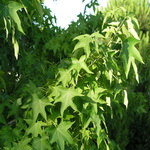| Common Name: |
Sweet Gum |
| Other Names: |
American Storax |
| Botanical Name: |
Liquidambar styraciflua |
| Genus: |
Liquidambar |
| Family: |
Hamamelidaceae |
| Native Location: |
E USA and Mexico |
| Cultivation: |
Deep, rich, moist, neutral to slightly acid soil in sun or partial shade. |
| Propagation: |
By seed sown in autumn; by greenwood cuttings in summer. |
| Harvest: |
Balsam is collected as a natural exudate, or from cuts in the bark, and made into syrups and tinctures. It is also extracted from the bark, after beating the trees to increase flow. |
| Height: |
30m (100ft) in the wild, 25m (80ft) in cultivation. |
| Width: |
12-20m (40-70ft) |
| Variations: |
Aurea
Has leaves striped and marbled yellow
Height: 15m (50ft)
Width: 8m (25ft) |
Lane Roberts
Turns deep maroon in autumn |
Variegata syn Worplesdon
Has long, narrowly lobed leaves, which turn purple, then yellow-orange in autumn. |
|
| Hardiness: |
Z5-9 |
| Parts Used: |
Balsam |
| Properties: |
An aromatic, stimulant herb that is antiseptic and anti-inflammatory, has expectorant effects. |
| Medicinal Uses: |
Internally for sore throats, coughs, colds, asthma, bronchitis, cystitis, and vaginal discharge. Externally for sores, hemorrhoids, ringworm, scabies, and frostbite. An ingredient of friar's balsam, a preparation based on benzoin (See Benzoin), which relieves colds and skin problems. |
| Economic Uses: |
Used in commercial flavoring of foods and tobacco. |
| Bibliography: |
Encyclopedia of Herbs by Deni Brown Copyright © 1995, 2001 Dorling Kindersley Limited Pp 264-5 |
